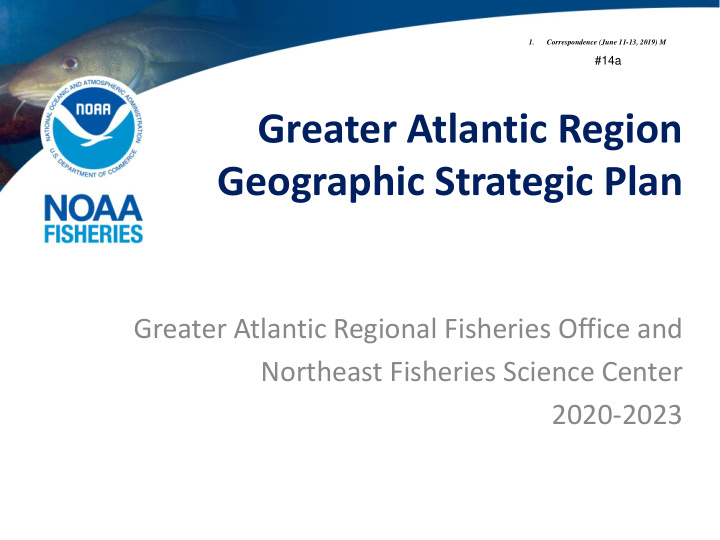



Correspondence (June 11-13, 2019) M 1. #14a Greater Atlantic Region Geographic Strategic Plan Greater Atlantic Regional Fisheries Office and Northeast Fisheries Science Center 2020-2023
Presentation Outline • Background information on previous plans • National and Regional Planning • Strategic Goals • Input on our “local landscape” U.S. Department of Commerce | National Oceanic and Atmospheric Administration | NOAA Fisheries | Page 2
Current Strategic Plans • Center and Regional Office strategic plans were done independently – some inconsistencies • GARFO Plan 2015-2019 • Established vision, goals, and objectives • Roles, responsibilities and tasks for all divisions • NEFSC Plans • Vision and mission objectives • Strategic Science Plan 2016-2021 • Director’s Annual Guidance Memo U.S. Department of Commerce | National Oceanic and Atmospheric Administration | NOAA Fisheries | Page 3
NOAA Strategic Planning Shift • Shift from independent to Joint Geographic Strategic Plans for each region • Improves coordination between NEFSC and GARFO • Geographic Strategic Plans share the same strategic goals as the NOAA Fisheries National Plan • More consistency throughout NOAA • Identify region-specific issues, challenges, and risks to…. • Develop region-specific management strategies to achieve goals U.S. Department of Commerce | National Oceanic and Atmospheric Administration | NOAA Fisheries | Page 4
Strategic Goals 1. Amplify the economic value of sustainable commercial and recreational fisheries 2. Conserve and recover protected species while supporting responsible fishing and resource development 3. Improve organizational excellence and regulatory efficiency U.S. Department of Commerce | National Oceanic and Atmospheric Administration | NOAA Fisheries | Page 5
The Local Landscape • Must be strategic and willing to move in new directions to adjust to an evolving environment • Focusing on prioritizing challenges and new opportunities • Consider critical needs and organizational limits • This is where we are asking for specific feedback from the Councils U.S. Department of Commerce | National Oceanic and Atmospheric Administration | NOAA Fisheries | Page 6
Issues We Have Identified • Rebuilding overfished stocks in a manner that promotes fishing industry resilience • Protecting endangered species and marine mammals while promoting responsible resource use • Changing climate, oceanic conditions, and coastal habitat affecting distribution, productivity, and sustainability of fish and other marine species and ecosystems U.S. Department of Commerce | National Oceanic and Atmospheric Administration | NOAA Fisheries | Page 7
Issues We Have Identified (continued) • Ocean acidification as a growing concern affecting fisheries, aquaculture, and marine ecosystems • Marine, estuarine, and riverine habitat loss • Increasing demands ( e.g., offshore wind energy, hydropower, infrastructure, new fisheries, and aquaculture) on resources and resources users • Identifying ecosystem-level species interactions and habitat productivity U.S. Department of Commerce | National Oceanic and Atmospheric Administration | NOAA Fisheries | Page 8
Challenges We Are Envisioning • Maintaining an adequate level of surveys and population assessments for marine resource management • Meeting the increased needs for assessment data and modeling capabilities to provide the most accurate catch advice • Addressing fisheries allocation issues in light of changes in fishery conditions, science, and management • Reducing regulatory burden while ensuring sustainable fisheries and protecting marine species • Promoting fishing community resiliency U.S. Department of Commerce | National Oceanic and Atmospheric Administration | NOAA Fisheries | Page 9
Challenges We Are Envisioning (continued) • Increasing catch of underutilized commercial fish stocks • Improving stability and opportunity in U.S. recreational fisheries • Reducing bycatch of non-target species while supporting commercial and recreational fisheries • Improving data collection processes and promoting efficient data integration • Innovative technologies hold promise but development and implementation are difficult U.S. Department of Commerce | National Oceanic and Atmospheric Administration | NOAA Fisheries | Page 10
Risks We Are Anticipating • NOAA’s aging infrastructure and availability/dependability of vessels could impact data collection critical for resource management • Enhancing our science and management capabilities to ensure the coexistence of sustainable fisheries and mixed-ocean uses • A greater workload than the available resources can address requires a priority-based approach (i.e., some workload will not be addressed) U.S. Department of Commerce | National Oceanic and Atmospheric Administration | NOAA Fisheries | Page 11
Process and Timeline 1. Request for all comments from Councils by June 28 2. We will revise the draft plan based on Council input 3. We share our revised draft with NMFS program offices (Habitat conservation, Protected Resources, Sustainable Fisheries, International Affairs, etc.) 4. Provide final draft to ASMFC and Councils by early August/September meetings 5. Submit final plan to headquarters in early October U.S. Department of Commerce | National Oceanic and Atmospheric Administration | NOAA Fisheries | Page 12
Common Questions and Answers Question – Why is NOAA only asking for our input on the “local landscape” Answer – We are trying to bring greater connectivity and consistency between our national and regional goals. These are the goals that NOAA has elected to focus on. Question – This seems very general and high level. Where are the details? Answer – We plan to develop additional Appendices that will include more detailed operational and implementation plans. Question – When will this plan be complete? Answer – We anticipate finalizing the strategic plan this fall. Implementation details will be developed after that. U.S. Department of Commerce | National Oceanic and Atmospheric Administration | NOAA Fisheries | Page 13
Discussion • Are there any issues unique to our management region that we have not identified? • What challenges do you envision we will spend our most time addressing? • What risks do you perceive as potentially impacting our ability to be successful? • What are we missing? U.S. Department of Commerce | National Oceanic and Atmospheric Administration | NOAA Fisheries | Page 14
Recommend
More recommend